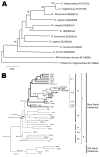Pygmy rice rat as potential host of Castelo dos Sonhos Hantavirus
- PMID: 21801642
- PMCID: PMC3381544
- DOI: 10.3201/eid1708.101547
Pygmy rice rat as potential host of Castelo dos Sonhos Hantavirus
Abstract
To study the dynamics of wild rodent populations and identify potential hosts for hantavirus, we conducted an eco-epidemiologic study in Campo Novo do Parecis, Mato Grosso State, Brazil. We detected and genetically characterized Castelo dos Sonhos virus found in a species of pygmy rice rat (Oligoryzomys utiaritensis).
Figures


References
-
- Iversson LB, Travassos da Rosa APA, Rosa MDB, Lomar AV, Sasaki MGM, Leduc JW. Infecção humana por hantavírus nas regiões Sul e Sudeste do Brasil. Rev Assoc Med Bras. 1994;40:85–92. - PubMed
-
- Travassos da Rosa ES, Mills JM, Padula PJ, Elkhoury MR, Ksiazek TG, Mendes WS, et al. Newly recognized hantaviruses associated with hantavirus pulmonary syndrome in northern Brazil: partial genetic characterization of viruses and serologic implication of likely reservoirs. Vector Borne Zoonotic Dis. 2005;5:11–9. 10.1089/vbz.2005.5.11 - DOI - PubMed
-
- Padula PJ, Rossi CM, Della Vale MO, Martínez PV, Colavecchia SB, Edelstein A, et al. Development and evaluation of a solid-phase enzyme immunoassay based on Andes hantavirus recombinant nucleoprotein. J Med Microbiol. 2000;49:149–55. - PubMed
Publication types
MeSH terms
Substances
LinkOut - more resources
Full Text Sources
Medical
